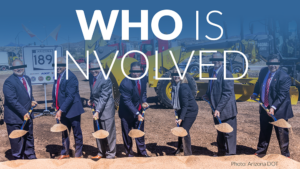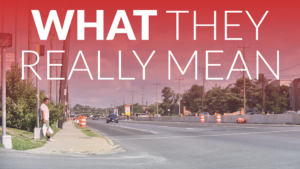Related Resources
Community Connectors Portal: Tools for advocates > How things happenProgramming 101 (project selection)
How are projects chosen for funding?
State DOTs have full discretion over which projects they prioritize and select for funding. This process (often called “programming”) is a critical step in deciding where and when shovels eventually end up in the ground. The most important part of the process to know and engage with is the State Transportation Improvement Program, the four-year list of projects that the state has committed to funding, planning, and building.
Projects are selected, or programmed, for funding through the state transportation improvement program (STIP)—a four-year, fiscally constrained (based on anticipated available funds) project list. The STIP must be updated at least every four years unless the governor establishes a more frequent timeline.
Projects in urbanized areas (i.e., areas over 50,000 people) are typically selected by metropolitan planning organizations (MPOs) in coordination with the state DOT and local governments. MPOs select their projects by preparing regional Transportation Improvement Programs (TIPs), which are then adopted as part of the STIP.1
How are projects selected for inclusion in the STIP?
As noted in our explainer on the planning process, the higher-level, long-range transportation planning processes don’t always have the most direct impact on what projects are chosen for the STIP. And states have a lot of flexibility in how they select projects.
There are some baseline requirements in federal law for the projects and process that guides the STIP, including:
- Setting and measuring performance targets
- Coordination with relevant bodies (MPOs, federal agencies, and more)
- Consistency with the long-range transportation plans (LRTP)
- Public involvement and comment
- Fiscal constraint, that is the selected projects have to line up with the available funding
How a state actually prioritizes projects can be based on a number of other factors:
- Asset conditions or management plans (e.g. bridge state of repair)
- Identified congestion, air quality, or safety problem areas (e.g. a cluster of crashes)
- Political influence, i.e, a project proposed by legislator, local elected, or stakeholder group (eg, business/manufacturer considering a site)
- National and state priorities (e.g.
Many times, projects are prioritized because they have support from a politically powerful elected leader or stakeholder group. Sometimes it is in response to press coverage of a problem. Often a project may be selected because it’s waited in the queue until its turn, as regularly happens with highways proposed decades ago, like the highways through sparsely populated rural areas in West Virginia or Alabama planned decades ago but just now moving forward thanks to new federal funding.
A select number of states are attempting to connect their decisions to their priorities in a quantitative way. Virginia’s project scoring process, known as Smart Scale, is much more comprehensive and equitable. (We wrote about it at length when it was just starting out here.)
How can you make sure you don’t get the short end of the STIP?
- Go look for your state STIP and read it. Google your state and STIP and it should come up.
- Review it and identify what you like and what you don’t. Raise these items to reporters and electeds.
- Evaluate the existing projects in the STIP against your state’s long-range priorities and goals. Do they line up? Do the projects advance the goals your state has laid out? Ask a reporter to look into this same question.
- Participate in the development of the next one through public engagement sessions.
- Fight for a more transparent project selection process like Virginia’s Smart Scale.






